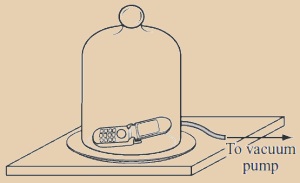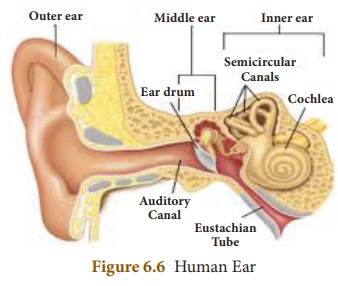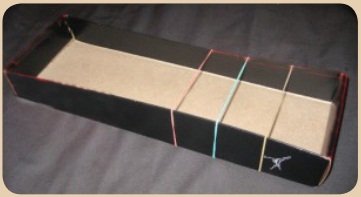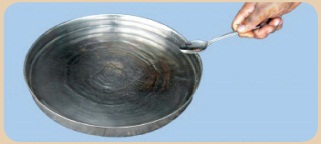Science : Chapter 6 : Sound
TEXTBOOK EXERCISES
I. Choose the best answer.
1. Sound waves travel very fast in
a. air
b. metals
c. vacuum
d. liquids
[Answer: (b) metals]
2. Which of the following are the characteristics of vibrations?
i. Frequency
ii. Time period
iii. Pitch
iv. Loudness
a) i and ii
b) ii and iii
c) iii and iv
d) i and iv
[Answer:(c) (iii) amd (iv)]
3. The amplitude of the sound wave decides its
a. speed
b. pitch
c. loudness
d. frequency
[Answer: (c) loudness]
4. What kind of musical instrument is a sitar?
a. String instrument
b. Percussion instrument
c. Wind instrument
d. None of these
[Answer: (a) String instrument]
5. Find the odd one out.
a. Harmonium
b. Flute
c. Nadaswaram
d. Violin
[Answer: (d) Violin]
6. Noise is produced by
a. vibrations with high frequency.
b. regular vibrations.
c. regular and periodic vibrations.
d. irregular and non-periodic vibrations.
[Answer: (d) irregular non-periodic vibrations]
7. The range of audible frequency for the human ear is
a. 2 Hz to 2000 Hz
b. 20 Hz to 2000 Hz
c. 20 Hz to 20000 Hz
d. 200 Hz to 20000 Hz
[Answer: (c) 20 Hz to 20000 Hz]
8. If the amplitude and frequency of a sound wave are increased, which of the following is true?
a. Loudness increases and pitch is higher.
b. Loudness increases and pitch is unchanged.
c. Loudness increases and pitch is lower.
d. Loudness decreases and pitch is lower.
[Answer: (a) Loudness increases and pitch is higher]
9. Which of the following may be caused by noise?
a. Irratition
b. Stress
c. Nervousness
d. All the above
[Answer: (d) all the above]
II. Fill in the blanks.
1. Sound is produced by vibrating bodies.
2. The vibrations of a simple pendulum are also known as oscillation.
3. Sound travels in the form of mechanical waves.
4. High frequency sounds that cannot be heard by you are called Ultrasonic.
5. Pitch of a sound depends on the frequency of the vibration.
6. If the thickness of a vibrating string is increased, its pitch decrease.
III. Match the following.
1. Ultrasonics – Frequency below 20Hz
2. Speed of sound in air – Needs materialmedium
3. Infrasonics – 330ms-1
4. Sound propagation – Frequency more than20000 Hz
Answer:
1. Ultrasonics : Frequency more than 20000 Hz
2. Speed of sound in air : 330 ms-1
3. Infrasonics : Frequency below 20Hz
4. Sound propagation : Needs material medium
IV. Consider the statements given below and choose the correct option.
A. Both assertion and reason are true and reason is the correct explanation of assertion.
B. Both assertion and reason are true but reason is not the correct explanation of assertion.
C. Assertion is true but reason is false.
D.Assertion is false but reason is true.
E. Both Assertion and reason are false.
1. Assertion: When lightning strikes, the sound is heard a little after the flash is seen.
Reason: The velocity of light is greater than that of the sound.
[Answer: (a) If both assertion and reason are true and reason is the correct explanation of assertion.]
2. Assertion: Two persons on the surface of moon cannot talk to each other.
Reason: There is no atmosphere on moon.
[Answer: (a) If both assertion and reason are true and reason is the correct explanation of assertion.]
V. Answer briefly.
1. What is vibration?
Answer: Vibration means a kind of rapid to and fro motion of an object.
2. Give an example to show that light travels faster than sound?
Answer: Lightning. The most common example of showing that light travels faster than sound is lightning. Whenever a lightning strikes, you see the lightning first and then hear the thunder after some time.
3. To increase loudness of sound by four times, how much should the amplitude of vibration be changed?
Answer: Loudness of a sound depends on the amplitude of the vibration. So to increase loudness of sound by four times, the amplitude of the vibration also to be increased by four times.
4. What is an ultrasonic sound?
Answer: A sound with a frequency greater than 20000 Hz is called as ultrasonic sound.
5. Give two differences between music and noise.
Answer:

Music
1.The sound that provides a pleasing sensation to the ear.
2. It is produced by the regular patterns of vibrations.
Noise
1. Sound that is unpleasant to the ear
2. It is produced by the irregular and non-periodic vibrations.
6. What are the hazards of noise pollution?
Answer:
(i) Noise may cause irritation, stress, nervousness and headache.
(ii) Long term exposure to noise may change the sleeping pattern of a person.
(iii) Sustained exposure to noise may affect hearing ability. Sometimes, it leads to loss of hearing.
(iv) Sudden exposure to louder noise may cause a heart attack and unconsciousness.
(v) Noise of horns, loud speakers, etc., cause disturbances leading to lack of concentration.
(vi) Noise pollution affects a person’s peace of mind.
7. Mention few measures to be taken to reduce the effect of noise pollution.
Answer: (i) Strict guidelines should be set for the use of loudspeakers on social, religious and political occasions.
(ii) All automobiles should have effective silencers.
8. Define the following terms. a. Amplitude b. Loudness
Answer:
(a) Amplitude : Amplitude is the maximum displacement of a vibrating particle from its mean position. It is denoted by ‘A’ and its unit is ‘metre’ (m).
(b) Loudness : It is defined as the characteristic of a sound that enables us to distinguish a weak or feeble sound from a loud sound. The unit of loudness of sound is decibel (dB).
9. How does planting trees help in reducing noise pollution?
Answer:
(i) Plant parts such as stems, leaves, branches wood, etc., absorb sound.
(ii) Rough bark and thick, fleshy leaves are particularly effective at absorbing sound due to their dynamic surface area and helps in reducing noise pollution.
VI. Answer in detail.
1. Describe an experiment to show that sound cannot travel through vaccum.
Answer:
Aim : To prove that sound cannot travel through vacuum and it needs a medium for propagation.
Materials Required : Bell jar, mobile phone and vacuum pump.

Procedure :
(i) Take a bell jar and a mobile phone.
(ii) Switch on the music in the mobile phone and place it in the jar.
(iii) Now, pump out the air from the bell jar using a vacuum pump.
(iv) As more and more air is removed from the jar, the sound from the mobile phone becomes feebler and finally, very faint.
Conclusion : This experiment proves that sound cannot travel in vacuum and it needs a medium.
2. What are the properties of sound?
Answer:
(a) Loudness
(b) Pitch
(c) Quality or Timbre
(a) Loudness:
(i) It is defined as the characteristic of a sound that enables us to distinguish a weak or feeble sound from a loud sound.
(ii) The loudness of a sound depends on its amplitude.
(iii) When a drum is softly beaten, a weak sound is produced. However, when it is beaten strongly, a loud sound is produced.
(iv) The unit of loudness of sound is decibel (dB).
(b) Pitch:
(i) The pitch is the characteristic of sound that enables us to distinguish between a flat sound and a shrill sound.
(ii) Higher the frequency of sound, higher will be the pitch. High pitch adds shrillness to a sound.
(iii) The sound produced by a whistle, a bell, a flute and a violin are high pitch sounds.
(c) Quality or Timbre :
(j) The quality or timbre is the characteristic of sound that enables us to distinguish between two sounds that have the same pitch and amplitude.
(i) For example in an orchestra, the sounds produced by some musical instruments may have the same pitch and loudness.
3. What steps should be taken to reduce the effect of noise pollution?
Answer:
(i) Strict guidelines should be set for the use of loudspeakers on social, religious and political occasions.
(ii) All automobiles should have effective silencers.
(iii) People should be encouraged to refrain from excessive honking while driving.’
(iv) Industrial machines and home appliances should be properly maintained.
(v) All communication systems must be operated in low volumes.
(vi) Residential areas should be free from heavy vehicles.
(vii) Green corridor belt should be set up around the industries as per the regulations of the pollution control board.
(viii) People working in noisy factories should wear ear plugs.
(ix) People should be encouraged to plant trees and to use absorbing materials like curtains and cushions in their home.
4. Describe the structure and function of the human ear?
Answer:
(i) The outer and visible part of the human ear is called pinna (curved in shape).
(ii) It is specially designed to gather sound from the environment, which then reaches the ear drum (tympanic membrane) through the ear canal.

(iii) When the sound wave strikes the drum, the ossicles move inward and outward to create the vibrations.
(iv) These vibrations are then picked up by special types of cells in the inner ear. From the inner ear the vibrations are sent to the brain in the form of signals.
(v) The brain perceives these signals as sounds.
VII. Problems.
1. Ruthvik and Ruha hear a gunshot 2 second after it is fired. How far away from the gun they are standing? (Speed of sound in air is equal to 330ms-1)
Solution :
Given data : time t = 2 s
Speed of sound V = 330 ms-1
To find : Distance d = ?
Formula : Distance = Speed × time
Distance d = 330 × 2 = 660 m
2. A sound wave travels 2000 m in 8 s. What is the velocity of the sound?
Solution :
Given data :
Distance travelled by a sound wave d = 2000 m
time taken t = 8 s
To find : Velocity of sound V = ?
Formula:
Volcity V = distance (d) / time(I)
V= 2000/8 = 250ms-1
3. A wave with a frequency of 500 Hz is traveling at a speed of 200 ms-1. What is the wavelength?
Solution :
Given data : Frequency n = 500 Hz
Speed V = 200 ms-1
To find : Wavelength λ = ?
Formula : Wavelength λ = Velocity (V) / Wavelength (n)
λ = 200/500 = 2/5= 0.4 m
4. What is the frequency of a mechanical wave that has a velocity of 25 ms 1 and a wavelength of 12.5 m?
Solution :
Given data : Frequency n = ?
Velocity V = 25 ms-1
Wavelength λ = 12.5m
To find: Frequency n = ?
Formuls: Frequency n = V(Velocity) / λ(Wavelength)
n = 25/12.5 = 2 Hz
Numerical problems
Problem 1
A sound has a frequency of 50 Hz and a wavelength of 10 m. What is the speed of the sound?
Solution
Given, n = 50 Hz, λ = 10m
v = nλ
v = 50 × 10
v = 500 ms-1
Problem 2
A sound has a frequency of 5 Hz and a speed of 25 ms-1. What is the wavelength of the sound?
Solution
Given, n = 5 Hz, v = 25 ms-1
v = nλ
λ = v/n = 25/5 = 5 m
Student Activities
Activity 1
Take the tray of an empty match box and stretch a rubber band around it, along its length. Then, pluck the stretched rubber band with your index finger. What do you observe? Do you hear any sound?

Answer:
Observation :
(i) On plucking the rubber band, it starts vibrating.
(ii) We can hear a feeble humming sound as long as the rubber band is vibrating.
(iii) The humming sound stops as soon as the rubber band stops vibrating.
Conclusion : This confirms that sound is produced by vibrating bodies.
Activity 2
Take a metal shallow pan. Hang it at a convenient place in such a way that it does not touch anything. Now, strike it with a stick. Touch the pan gently with your index finger. Do you feel the vibrations? Again, strike the pan with the stick and hold it tightly with your hands, immediately after striking. Do you still hear the sound?

Answer:
Case 1 :
(i) Now, strike it with a stick.
(ii) Touch the pan gently with your index finger. Do you feel the vibrations?
Observation :
we can the feel the vibration for sometime.
Case 2 :
(i) Strike the pan with the stick and hold tightly with your hands, immediately after striking.
(ii) Do you still hear the sound?
Observation :
we cannot hear the sound.
Conclusion : This activity shows the vibrating pan produces sound.
This activity shows that vibrating pan produces sound. In this case vibrations can be felt by touching the pan. But in some cases vibrations are visible.
Activity 3
Take a metal dish, pour some water in it. Strike it at its edge with a spoon. Do you hear any sound? Again strike the dish and touch it. Can you feel the dish vibrating? Look at the surface of water. Do you see any movement on the water surface? Now, hold the dish with your hands. What change do you observe on the surface of the water?

Answer: We see that a vibrating object produces sound.
Again strike the dish and touch it. Can you feel the dish vibrating?
Answer: I can feel the dish vibrating.
Strike the dish again. Look at the surface of water. Do you see any movement on the water surface?
Answer: I can see the waves on the surface of water.
Now, hold the dish. What change do you observe on the surface of water?
Answer: I cannot see the waves on the surface of water.
Activity 4
Take a bell jar and a mobile phone. Switch on the music in the mobile phone and place it in the jar. Now, pump out the air from the bell jar using a vacuum pump. As more and more air is removed from the jar, the sound from the mobile phone becomes feebler and finally, very faint.

Answer:
Aim : To prove that sound cannot travel through vacuum and it needs a medium for propagation.
Materials Required : Bell jar, mobile phone and vacuum pump.
Procedure :
(i) Take a bell jar and a mobile phone.
(ii) Switch on the music in the mobile phone and place it in the jar.
(iii) Now, pump out the air from the bell jar using a vacuum pump.
(iv) As more and more air is removed from the jar, the sound from the mobile phone becomes feebler and finally, very faint.
Conclusion : This experiment proves that sound cannot travel in vacuum and it needs a medium.
Activity 5
Take two stones and strike them together and listen to the sound produced by them. Now take the stones underwater and strike them. You will find that the sound produced by the stones underwater is feeble and not very clear.
Answer:
Observation : We observe that the sound produced by the stones undewater is feeble and not very clear.
Conclusion : This activity shows that the speed of sound depends on the properties of the medium through which it travels.
Activity 6
Throw a stone into a pool of still water. It produces waves, which spread rapidly over the surface of water and they travel in all directions. Do water particles move away from the point of disturbance? Check it by placing grains of saw dust over the water. They do not move away. Instead they merely move up and down about their mean position. Similarly, sound travels in the form of a wave.
Thomas Alva Edison, in 1877 invented the phonograph, a device that played the recorded sound.
More to know
Wavelength is the distance between two consecutive particles, which are in the same phase of vibration. It is denoted by the Greek letter ‘λ’. The unit of wavelength is metre (m).
Frequency is the number of vibrations of a particle in the medium, in one second. It is denoted by ‘n’. The unit of frequency is hertz (Hz).
More to know
The amount of water vapour present in the air is known as humidity. It is less during winter and more during summer. The speed of sound increases with increase in humidity. This is because the density of air decreases with increase in humidity.
How do astronauts communicate with each other? The astronauts have devices in their helmets which transfer the sound waves from theirvoices into radio waves and transmit it to the ground (or other astronauts in space). This is exactly the same as how radio at your home works.
The seismic wave formed during earthquake is an example for a longitudinal wave. Waves travelling through the layers of the Earth due to explosions, earthquakes and volcanic explosions are called seismic waves. Using a hydrophone and seismometer one can study these waves and record them. Seismology is the branch of science that deals with the study of seismic waves.
More to know
Amplitude is the maximum displacement of a vibrating particle from its mean position. It is denoted by ‘A’. The unit of amplitude is ‘metre’ (m).
A bat can hear the sounds of frequencies higher than 20,000 Hz. Bats produce ultrasonic sound during screaming. These ultrasonic waves help them to locate their way and the prey.














